
Written by Majkol Robuschi on 13 Oct 2025
Distributor GungHo • Price £69.99
Riding the wave of success collected by recent installments, Falcom returns to the origins of the Trails series, historically part of the classic "The Legend of Heroes" brand, to offer a solid starting point for new players. Trails in the Sky 1st Chapter is, in fact, the inaugural part of a story that recounts a fantasy universe through military tensions seasoned with a dash of political fiction. This intervention is likely a necessary one, considering The Legend of Heroes: Trails in the Sky was originally launched for Asian computers alone back in 2004.
Today, the Trails saga boasts well over ten titles, including sequels and spin-offs, published between 2006 and 2024, with the latest iteration of the franchise, The Legend of Heroes: Trails Beyond the Horizon, scheduled for a Western release in early 2026. But where does the appeal of this successful turn-based RPG series lie? Trails undoubtedly shines through its extremely sophisticated approach to dialogue writing, characterisation, and world-building; yet the masterstroke that endears the series to fans and intrigues newcomers is the inspired choice to explore various perspectives across its different episodes. The narrative shifts through time and space to intimately recount the backstories driving the relationships between conflicting kingdoms, with stories evolving within military ranks and exploring distinct cultures.
However, one shouldn't think that the Falcom series completely detaches itself from the narrative tropes and conventions of the JRPG genre aimed at a young audience, defining itself as a uniquely serious entity within a production normally marked by more lighthearted tones. On the contrary, the Trails saga wholeheartedly embraces all the narrative stylings of coming-of-age tales with young actors from the popular adolescent storytelling landscape, doing so with a genuine tone and without forcing the inclusion of overly complex or mature themes. In this first chapter, the "feel-good" tone with which events are approached certainly makes the experience more digestible, though some might perceive a narrative simplicity ill-suited to the project's overarching ambitions.
Despite its simplicity, Trails in the Sky 1st Chapter perfectly embodies what has been described thus far, centering on the young and energetic Estelle and her mild-mannered adoptive brother Joshua. These two heroes are committed to following in the footsteps of their father, a warrior famous throughout the Kingdom of Liberl. They soon dedicate their time to climbing the ranks of the Bracer Guild, a non-governmental association with branches in every kingdom of the narrative world, founded to maintain peace and protect the weak. This very goal serves as the catalyst for their adventure into the surrounding regions, leading them on a path of personal growth and the discovery of revelations far more shocking than anything they could have previously imagined.
Although the story closely follows the efforts of both siblings, the perspective is generally that of young Estelle, a female protagonist initially presented as a good-natured and intensely optimistic girl. The progression of the adventure manages to explore her psychology, defining a kind of evolution in the bond she shares with her constant companion, Joshua. The feelings they harbor for each other, and the evolution of their relationship, are the pivot around which the story's most interesting dynamics unfold, which is otherwise busy recounting mini-narrative arcs coinciding with the exploration of a different region of the Kingdom of Liberl. This structure provides opportunities to enrich the relational dynamics between the two with new co-protagonists introduced at every stop, culminating in a grand, choral narrative in the final act when the entire cast finally reunites to thwart the schemes of machinations that were, until then, not entirely clear.
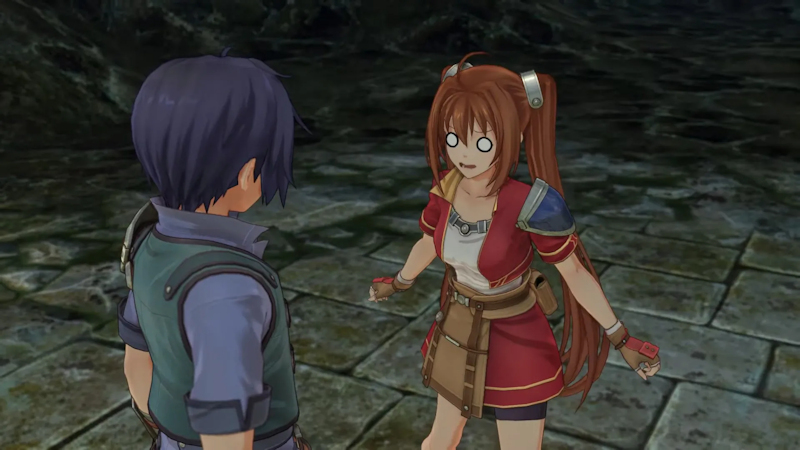
Say what you want, but Estelle is such a cool heroine.
It’s interesting to note how Trails in the Sky 1st Chapter does present a situational narrative, but one capable of weaving the threads of a mystery that remains unsolved until the final moments of its story, culminating in a resolution that is at times shocking but perfectly sets the stage for a sequel with far more epic and emotional tones. This is also perhaps the greatest weakness of Falcom's narrative offering here: its entire plotline is a preparation for what is to come in the next chapter. This narrative structure might seem imbalanced at first glance—with the most interesting parts coinciding with the concluding moments—but it has nonetheless captivated audiences, creating a growing interest around the title.
The necessity of introducing an entire, finely-wrought fantasy universe through well-written dialogues, the presence of books to consult for lore, and hundreds of optional NPC dialogues revealing the daily life and history of Liberl, are all elements aimed at fully immersing the player in the folds of a geopolitical cosmology that could be narrated in a series of young adult fantasy novels. An ambition that has certainly paid off for Falcom's vision, given the success the series now enjoys among JRPG enthusiasts, but which might deter those seeking a less verbose narrative structure more focused on the core characters.
Naturally, this doesn't mean that protagonists and supporting characters aren't explored over the forty hours required to complete the game, but the emphasis is placed solely on the relationship between Estelle and Joshua, two "masks" so stereotypical of the Japanese narrative imagination that it’s easy to predict how their story will evolve, even without looking at images or spoilers from subsequent chapters. Although their story remains predictable—especially in the eyes of an experienced player—the delicate bond between them, filled with unspoken words and misunderstandings typical of young adult romantic comedies, remains well-written and, most importantly, well-told in competently staged cinematic scenes, using direction shrewdly to convey the strength of their feelings and insecurities.
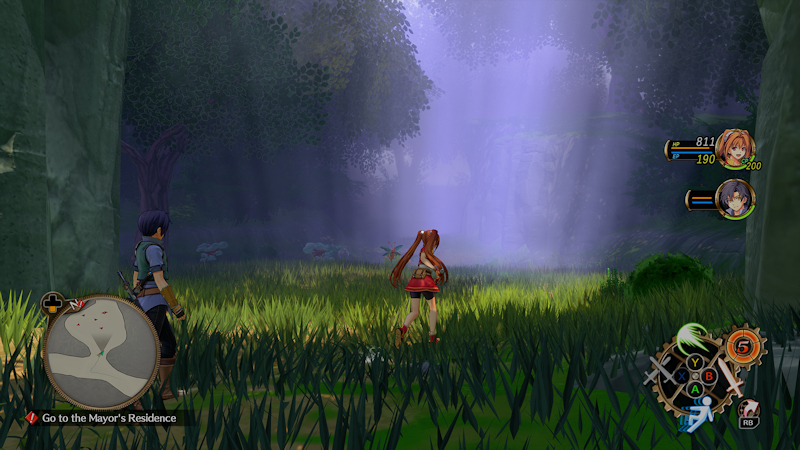
Some of the initial dungeons are very promising, but the variety in terms of exploration stays limited.
The remaining co-protagonists and allies are still pleasant, and the interactions within the group of heroes, while not reaching the excellence of the numerous skits in the Tales of series, are well-characterized with light tones. As this is the first chapter of a far-reaching story, it's clear there will be time to discover more about the backstories and nuances of the characters who stand out less in Trails in the Sky 1st Chapter, considering their limited screen time.
Trails in the Sky 1st Chapter presents itself as a formally perfect 3D remake. It genuinely reflects the tone and content of the original video game, celebrating its memory with a modernized gameplay structure for today's players, without any second thoughts.
Most of the new mechanical novelties driving the gameplay draw from the structure of the recent title The Legend of Heroes: Trails Through Daybreak, adopting its formula and combining it with all the elements inherent to the first Trails chapter.
Exploration of the Kingdom of Liberl is free, with vast interconnected maps that encourage the exploration of lush regions inhabited by monstrous creatures. Players can engage enemies using a fast, Ys-style hack 'n' slash formula, landing blows and dodging enemy responses at the right moment to quickly charge the typical "super move" gauge, also relying on the ability to switch between available characters and use combination attacks. Alternatively, players can opt for turn-based battles featuring more classic dynamics, provided these aren't triggered by a pre-emptive enemy strike, in which case the battle starts with enemies gaining priority in the turn order.
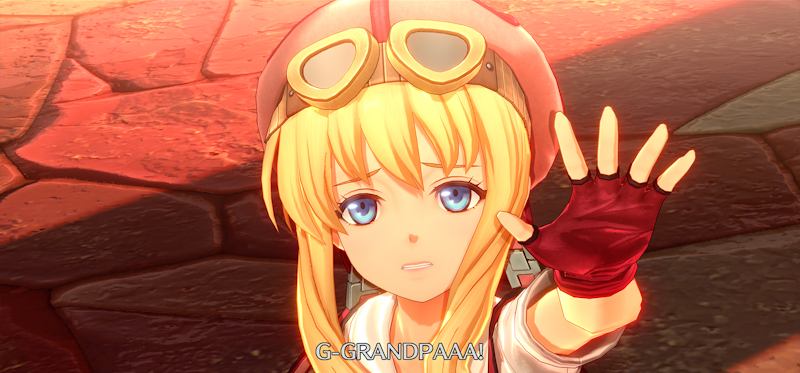
Each mini-arc set in the different regions of Liberl introduces a new companion. but the whole squad will reunite only at the end of the story.
In this instance, the game becomes decidedly more strategic, allowing the use of classic magic attacks linked to the elemental orbs—typical of the series—or techniques available to characters that enjoy bonuses depending on their positioning on the map: certain techniques grant bonuses if executed behind opponents, while elemental affinities and weaknesses must be complemented by the ability to slow down the opponent's turn, or even cancel their action, such as casting a spell. This is joined by other mechanics borrowed from subsequent chapters, such as a temporary power-up system called Overdrive. Naturally, the remake respects the turn-based RPG nature of the episode it references, and the emphasis in fundamental battles is always placed on choosing the turn-based system, delegating the optional use of hack 'n' slash combat to the exploration phases, perhaps to speed up grinding and character leveling when venturing into the typical dungeons.
The balance between the two worlds—the action and the classically turn-based—is also promoted by a series of Quality-of-Life options that considerably streamline the experience, for example, speeding up animations during battle, or even allowing the exploration of the Liberl region in fast forward. This is a significant addition, considering that the entire explorable map is a 1:1 translation of the original vision. In terms of level design, however, Trails in the Sky 1st Chapter does not stand out for complexity of execution, relying on maps typically featuring sporadic vertical evolution or rare hidden rooms. Dungeons are indeed labyrinthine but also feel samey and fail to enrich the formula with unique features like environmental puzzles. Evidently aware of this, the developers have allowed everything to be explored at a dynamic speed, at the player's discretion; I must admit I played the entire adventure making extensive use of the fast-forward mode due to this.
Trails in the Sky 1st Chapter also introduces a convenient fast navigation system that not only allows quick travel between points on the map but also introduces helpful markers that allow players to easily follow side quests and optional events, completely simplifying the difficult completion of the original chapter's Bracer missions. Consequently, the already more-than-manageable challenge of combat is paired with a very straightforward exploration model, resulting in a gameplay experience that remains not particularly demanding on the normal difficulty setting. However, it can be tackled at any time on higher challenge levels, like the historic Nightmare difficulty. Given the flexibility offered by the developers, it's clear Falcom wants to give players free rein to shape the gameplay experience that best suits their habits, with a clear eye toward accessibility.
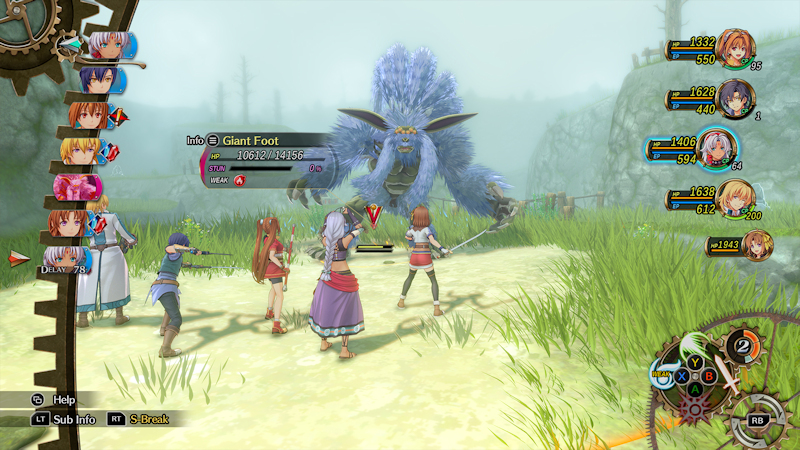
Some techniques offer area damage, but elemental magic is generally more effective against monsters.
Last, but certainly not least, is the praise I feel compelled to give Falcom for the aesthetic and graphical presentation of this Trails in the Sky 1st Chapter. Always far from being a standout development house in the purely technological field, the Ys software house has nonetheless managed to recreate the world of The Legend of Heroes: Trails in the Sky in an extremely convincing and visually pleasing way. This remake flexes the muscles of a high-level graphics department, especially when looking at the three-dimensional modeling of the protagonists and their expressiveness, also enriched by gag deformations typical of Japanese animation. Battles are characterized by polished animations and the extensive use of cinematics enhanced by particle and light effects to emphasize the power and spectacle of the protagonists' Craft techniques.
As was easy to expect, the same level of care is not found throughout the game, where secondary and background characters betray the obvious use of assets coming from other company titles, while the environments fail to convey the sensation of a true journey between different regions, limited to reiterating the same landscape offered from the very first moments of the game. This fact, although true, does not scratch Falcom's achievement in the purely production phase for even a moment and is limited to strongly secondary aspects of the gameplay experience. An example of the care in realization can be noted in the cities, inhabited by lively NPCs, engaged in different activities depending on the moment in the game and with contextual animations that contribute to making the exploration of their streets dynamic and convincing experiences. Despite the limited cast of main characters and the high-impact, meticulously detailed cinematics, one could argue that the sum of the elements is greater than any single contribution when considering the game's overall scenic design.
The sound design is excellent—as always—and offered in three versions: the classic original score, the rearranged version from the previous remaster, and a new rearrangement closer to the original sound. Less convincing is the English voice cast, led by Stephanie Sheh voicing the bubbly Estelle. Sheh sometimes proves capable of bringing the iconic protagonist's most emphatic and playful moments to life, but she is decidedly less effective when the register shifts to a more dramatic tone. Even Johnny Yong Bosch—normally a guarantee of quality—seems less versatile in the role of Joshua, particularly when handling the more comedic moments related to cross-dressing or the adolescent tenderness with which he addresses Estelle. In both cases, it seemed the voice casting for the protagonists didn't fully account for the strongly adolescent tone of their characters, favoring more mature-sounding voices.
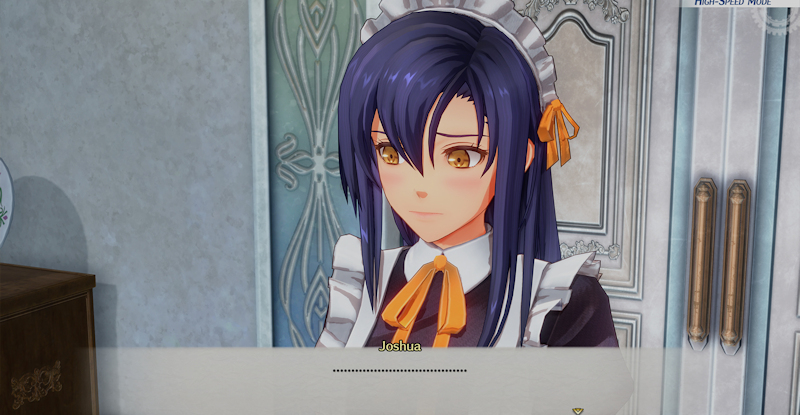
As you would expect from a typical "shoujo" style novel, the male lead is often compared to a beautiful woman.
The Japanese voice cast has been largely revolutionized, with younger voice actors, among whom Tomoyo Takayanagi (Sarina in Oshi no Ko) certainly stands out as Estelle. In general, I preferred the Japanese track, which proved capable of offering an interpretation absolutely worthy of the title's fame, although it must be underlined that—surprisingly—many parts of the game are not voiced.
The new script translation departs from the emphatic—and often colorful—tones of the script used for the original chapter's Western release, curated by publisher XSeed. The new English translation is, on paper, more faithful to the original writing, but I admit it might disappoint those who fell in love with the over-the-top quips of Estelle and company. The game's enjoyment is in no way diminished by this re-translation (inconsistencies in glossary aside, especially for series continuity), but one could almost say the characters—now translated without any poetic license—sound a bit more restrained compared to the past.
The final result of this operation can only bode well for the continuation of the remake process, which will proceed in the future with the already announced re-making of the second chapter of the Trails saga. And there, the story will be able to accelerate from the very beginning.
Trails in the Sky 1st Chapter is a return to roots that masterfully balances fidelity and modernity. Falcom demonstrates once again its intimate knowledge of its own legacy, delivering to a contemporary audience a tale capable of moving players despite its formally simple, classic-toned RPG structure. The remake doesn't overhaul; it refines. It refreshes the aesthetic, celebrates the memory of its protagonists, lightens the pace, and makes an adventure that retains all the warmth and sincerity of the original chapter's pastoral atmosphere more accessible. Trails in the Sky 1st Chapter remains a living testament to how the power of feelings and genuine writing can still sustain an entire narrative universe today.

Majkol (aka Zaru) is an Italian queer writer (he/him – they/them) who has been immersed in the world of video game journalism for almost two decades. With a deep-seated love for anime and manga shaping his tastes and passion, he brings a blend of critical insight and heartfelt enthusiasm to his work, celebrating stories that challenge norms and embrace diversity. Find him on his blog, Also sprach zaru_thustra.
posted by Ross Locksley on 07 Oct 2025
posted by Majkol Robuschi on 03 Oct 2025
posted by Ross Locksley on 30 Sep 2025
posted by Ross Locksley on 24 Sep 2025
posted by Ross Locksley on 19 Sep 2025
posted by Ross Locksley on 18 Sep 2025
posted by Majkol Robuschi on 17 Sep 2025
posted by Ross Locksley on 16 Sep 2025